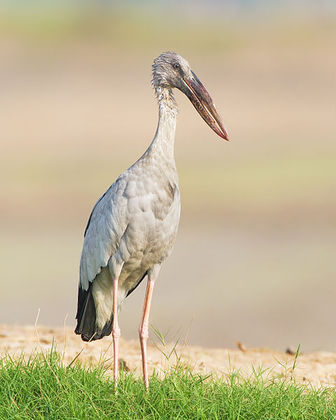Asian Openbill
Asian Openbill Stork is a broad-winged soaring bird, which relies on moving between thermals of hot air for sustained flight. Like all storks, it flies with its neck outstretched. It is relatively small for a stork at 68 cm length. They breed near inland wetlands and build stick nest in trees, typically laying 2-6 eggs.

Original source: Own work
Author: JJ Harrison (http://www.noodlesnacks.com/)Camera location
The Asian Openbill is classified as Least Concern. Does not qualify for a more at risk category. Widespread and abundant taxa are included in this category.
The Asian Openbill is very different from the other storks I've seen from their bill and also the color of their plumage. I love learning about Nature. Thanks for sharing and the interesting info. DarkBroomer Action: | Ignore User Viewing: 1 - 1 Page: 1 New CommentPost Your Comments Create a username. More
Asian Openbill (Anastomus oscitans) feeding in shallow waters in Kolkata W IMG 4441.jpgAsian Openbill (Anas... 138,294 bytes Asian Openbill (Anastomus oscitans) heronery in Uppalpadu, AP W IMG 2656.jpgAsian Openbill (Anas... 228,826 bytes Asian Openbill (Anastomus oscitans) heronery in Uppalpadu, AP W IMG 2827.jpgAsian Openbill (Anas... 187,518 bytes Asian Openbill (Anastomus oscitans) heronery in Uppalpadu, AP W IMG 2935.jpgAsian Openbill (Anas... More
The Asian Openbill or Asian Openbill Stork, Anastomus oscitans, is a large wading bird in the stork family Ciconiidae. It is a resident breeder in tropical southern Asia from India and Sri Lanka east to Southeast Asia. Asian Openbill Stork is a broad-winged soaring bird, which relies on moving between thermals of hot air for sustained flight. Like all storks, it flies with its neck outstretched. It is relatively small for a stork at 68 cm length. More
Anastomus oscitans (the Asian Openbill, as previously advertised) is “A large black and white bird which flies with its neck outstretched. This is the only remaining stork which can be seen with any regularity in Thailand.” Large means up to 81 cm, which really is quite big compared to the birds available in the UK and outside a battery farm. The A.O. More
Asian Openbill pair on nest Juvenile Asian Openbill Diet / Feeding The Asian Openbill Stork, like most of its relatives, walks slowly and steadily on the ground, feeding on molluscs, frogs and large insects. Copyright: Wikipedia. This article is licensed under the GNU Free Documentation License. It uses material from Wikipedia. More
Picture of the setting sun with Asian openbill stork in silhouette at breeding grounds in Thailand. the stork has different names: Asian Openbill, Asian openbill stork, open-bill stork, White Open billed stork, Anastomus oscitans, Family CICONIIDAE (Storks). Photo copyright photographer Soren Breiting with no. AJM4C2. Click on the picture or here to get more information of using this high resolution licensed stock photo. Picture of the setting sun with Asian openbill storks in silhouette at breeding grounds in Thailand. More
The Asian Openbill is one of six species of storks which have bred in Thailand, and the only one still found in any numbers. Like most of the country’s waterbirds, the storks have suffered from habitat losses, hunting, and disturbance. A paper on Thailand’s larger waterbirds by ornithologists Phil Round, Bubphar Amget, Jira Jintanugol and Utai Treesucon makes for mostly gloomy reading. More
Asian Openbill Stork is a broad-winged soaring bird, which relies on moving between thermals of hot air for sustained flight. Like all storks, it flies with its neck outstretched. It is relatively small for a stork at 68 cm length. They breed near inland wetlands and build stick nest in trees, typically laying 2-6 eggs. Breeding adults are all white except for the black wing flight feathers, red legs and dull yellow-grey bill. More
Asian Openbill is a small stork with conspicuous gap in its bill, allowing the bird to catch its preferred food, the freshwater snails. Adult has white plumage in breeding season, and pale grey for rest of the year. Scapulars, flight feathers and tail are black. Head is white or grey. The open bill is formed by a hollow in the lower mandible. Both mandibles meet at tip. Large, strong bill is pale pinkish-grey. Eyes are dark brown. More
The Asian Openbill Stork, like most of its relatives, walks slowly and steadily on the ground, feeding on mollusks, frogs and large insects. * The mandible is a bird’s upper or lower beak. More

Original source: Darrin OBrien
Author: Darrin OBrien
Permission: Some rights reserved
Family : Ciconiidae
Genus : Anastomus
Species : oscitans
Authority : (Boddaert, 1783)
